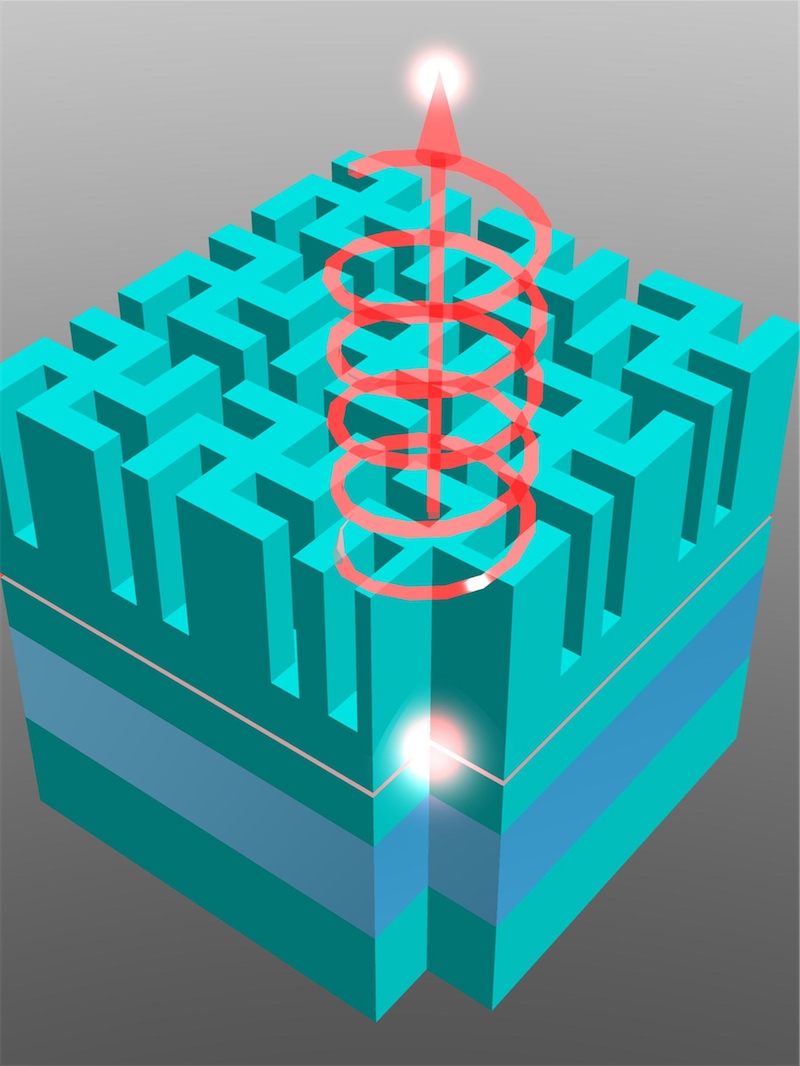Giving Light a Spin
Circularly polarized light, which is used in 3D movies, has its electric field vector rotating like a clock hand. It’s typically produced by sending light through a filter, but now a team has created a small, solid device that emits partially circularly polarized light, as they describe in the 4 February Physical Review Letters. If this semiconductor technology can be further perfected, it could be used in devices that help biochemists control protein synthesis or help physicists control electrons in spintronics–a futuristic type of electronics.
If circularly polarized light is coming toward you, its electric field vector rotates like the second hand of a clock, tracing out a helix as it travels. Biochemists use this light to control the synthesis of amino acids and other molecules that come in two mirror-image types, like left- and right-handed gloves. Physicists are also interested in circularly polarized light for manipulating the spin state of electrons in spintronic devices, which make use of the spin of the electron rather than its charge.
Ordinary, unpolarized light can be thought of as an equal mixture of clockwise- and counterclockwise-rotating, circularly polarized waves. To create pure, circularly polarized light, a filter can absorb one polarization state and let the other pass through. Such filters are not hard to make, but they are inefficient, since half of the initial light is lost. Liquid crystals are known to emit circularly polarized light, and light from certain semiconductors can become polarized when a magnetic field is used [1]. But these systems are rather large and inflexible in their design.
To make a more compact, semiconductor device, a University of Tokyo team led by Makoto Kuwata-Gonokami investigated so-called planar chiral nanostructures–two-dimensional arrays of tiny shapes that lack mirror symmetry. They chose a repeating pattern of micron-wide, spiral-like shapes called swastikas or gammadions, which were etched into the surface of a gallium arsenide semiconductor to a depth of about half a micron. Recently, similar sorts of arrays have been shown to rotate the polarization direction of light reflecting off of their surface [2].
Taking this experiment a step further, Kuwata-Gonokami and his collaborators embedded below the gammadions a layer of quantum dots, which are semiconductor islands that radiate unpolarized light at wavelengths characterized by their size. When a laser beam excited the embedded dots, the emission coming out through the gammadion layer was circularly polarized by as much as 26 percent. The orientation of this polarization depended upon the direction of the gammadion arms–whether they pointed clockwise or counterclockwise.
It would be natural to assume that the gammadion array was acting like a polarizing filter, but the researchers showed that this was not the case. They sent light through their device using an external source and found that the transmitted light had an entirely different polarization spectrum than the emission from the embedded dots. The team concluded that the gammadion layer should be considered a microcavity that determines which modes of light the dots can emit, much as the cavity of a musical instrument determines which wavelengths of sound are produced. Numerical simulations based on this microcavity model matched the experimental results. Unlike a conventional filter, the new technique can generate polarized light without any loss of photons, says University of Tokyo team member Kuniaki Konishi.
“The idea and the realization are very elegant,” says Sergei Tikhodeev of the Russian Academy of Sciences in Moscow. He says the micron-scale system has the advantage of being much smaller than other sources of circularly polarized light. The polarization is still far from 100 percent, points out Darren Bagnall of the University of Southampton, but “this work shows that it might be possible to construct a ‘device’ that efficiently emits light of not only particular wavelengths in certain directions, but now also polarization state.”
–Michael Schirber
Michael Schirber is a Corresponding Editor for Physics Magazine based in Lyon, France.
References
- X. Jiang, R. Wang, R. M. Shelby, R. M. Macfarlane, S. R. Bank, J. S. Harris, and S. S. P. Parkin, “Highly Spin-Polarized Room-Temperature Tunnel Injector for Semiconductor Spintronics using MgO(100),” Phys. Rev. Lett. 94, 056601 (2005)
- A. Papakostas, A. Potts, D. M. Bagnall, S. L. Prosvirnin, H. J. Coles, and N. I. Zheludev, “Optical Manifestations of Planar Chirality,” Phys. Rev. Lett. 90, 107404 (2003)
More Information
classification of polarization states of light from Georgia State University





